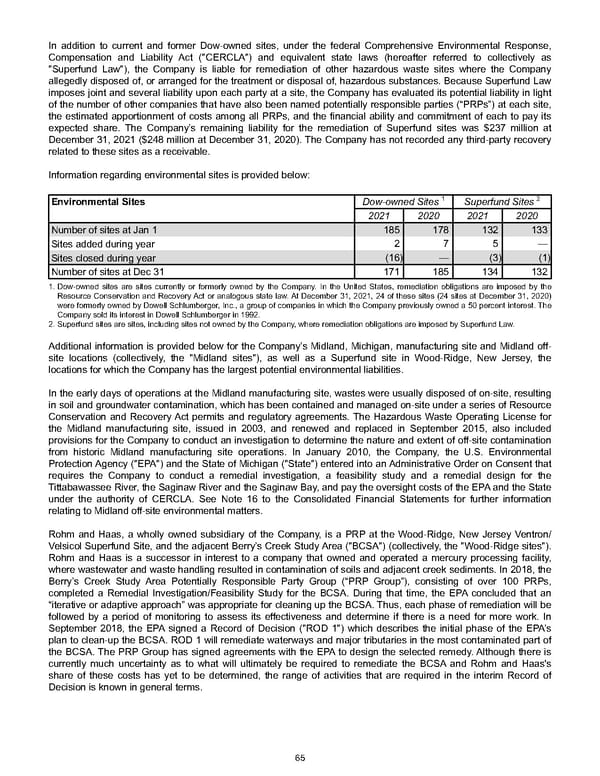In addition to current and former Dow-owned sites, under the federal Comprehensive Environmental Response, Compensation and Liability Act ("CERCLA") and equivalent state laws (hereafter referred to collectively as "Superfund Law"), the Company is liable for remediation of other hazardous waste sites where the Company allegedly disposed of, or arranged for the treatment or disposal of, hazardous substances. Because Superfund Law imposes joint and several liability upon each party at a site, the Company has evaluated its potential liability in light of the number of other companies that have also been named potentially responsible parties (“PRPs”) at each site, the estimated apportionment of costs among all PRPs, and the financial ability and commitment of each to pay its expected share. The Company’s remaining liability for the remediation of Superfund sites was $237 million at December 31, 2021 ( $248 million at December 31, 2020 ). The Company has not recorded any third-party recovery related to these sites as a receivable. Information regarding environmental sites is provided below: Environmental Sites Dow-owned Sites 1 Superfund Sites 2 2021 2020 2021 2020 Number of sites at Jan 1 185 178 132 133 Sites added during year 2 7 5 — Sites closed during year (16) — (3) (1) Number of sites at Dec 31 171 185 134 132 1. Dow-owned sites are sites currently or formerly owned by the Company. In the United States, remediation obligations are imposed by the Resource Conservation and Recovery Act or analogous state law. At December 31, 2021 , 24 of these sites ( 24 sites at December 31, 2020 ) were formerly owned by Dowell Schlumberger, Inc., a group of companies in which the Company previously owned a 50 percent interest. The Company sold its interest in Dowell Schlumberger in 1992. 2. Superfund sites are sites, including sites not owned by the Company, where remediation obligations are imposed by Superfund Law. Additional information is provided below for the Company’s Midland, Michigan, manufacturing site and Midland off- site locations (collectively, the "Midland sites"), as well as a Superfund site in Wood-Ridge, New Jersey, the locations for which the Company has the largest potential environmental liabilities. In the early days of operations at the Midland manufacturing site, wastes were usually disposed of on-site, resulting in soil and groundwater contamination, which has been contained and managed on-site under a series of Resource Conservation and Recovery Act permits and regulatory agreements . The Hazardous Waste Operating License for the Midland manufacturing site, issued in 2003, and renewed and replaced in September 2015, also included provisions for the Company to conduct an investigation to determine the nature and extent of off-site contamination from historic Midland manufacturing site operations. In January 2010, the Company, the U.S. Environmental Protection Agency ("EPA") and the State of Michigan ("State") entered into an Administrative Order on Consent that requires the Company to conduct a remedial investigation, a feasibility study and a remedial design for the Tittabawassee River, the Saginaw River and the Saginaw Bay, and pay the oversight costs of the EPA and the State under the authority of CERCLA. See Note 16 to the Consolidated Financial Statements for further information relating to Midland off-site environmental matters. Rohm and Haas, a wholly owned subsidiary of the Company, is a PRP at the Wood-Ridge, New Jersey Ventron/ Velsicol Superfund Site, and the adjacent Berry’s Creek Study Area ("BCSA") (collectively, the "Wood-Ridge sites"). Rohm and Haas is a successor in interest to a company that owned and operated a mercury processing facility, where wastewater and waste handling resulted in contamination of soils and adjacent creek sediments. In 2018, the Berry’s Creek Study Area Potentially Responsible Party Group (“PRP Group”), consisting of over 100 PRPs, completed a Remedial Investigation/Feasibility Study for the BCSA. During that time, the EPA concluded that an “iterative or adaptive approach” was appropriate for cleaning up the BCSA. Thus, each phase of remediation will be followed by a period of monitoring to assess its effectiveness and determine if there is a need for more work. In September 2018, the EPA signed a Record of Decision ("ROD 1") which describes the initial phase of the EPA’s plan to clean-up the BCSA. ROD 1 will remediate waterways and major tributaries in the most contaminated part of the BCSA. The PRP Group has signed agreements with the EPA to design the selected remedy. Although there is currently much uncertainty as to what will ultimately be required to remediate the BCSA and Rohm and Haas's share of these costs has yet to be determined, the range of activities that are required in the interim Record of Decision is known in general terms. 65
 Annual Report Page 74 Page 76
Annual Report Page 74 Page 76